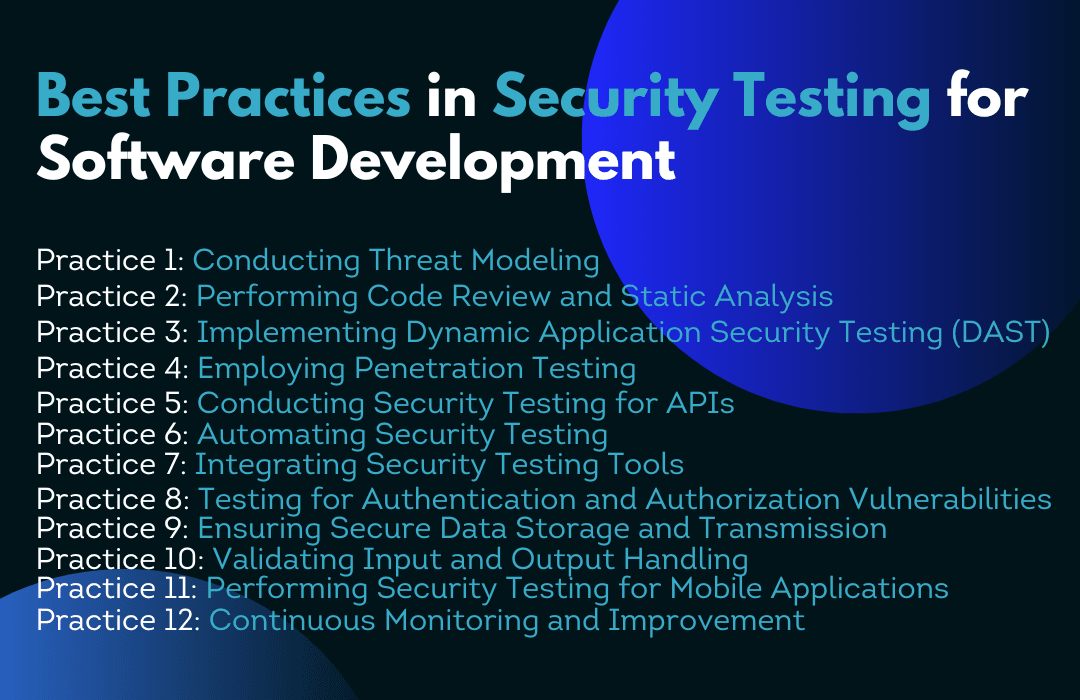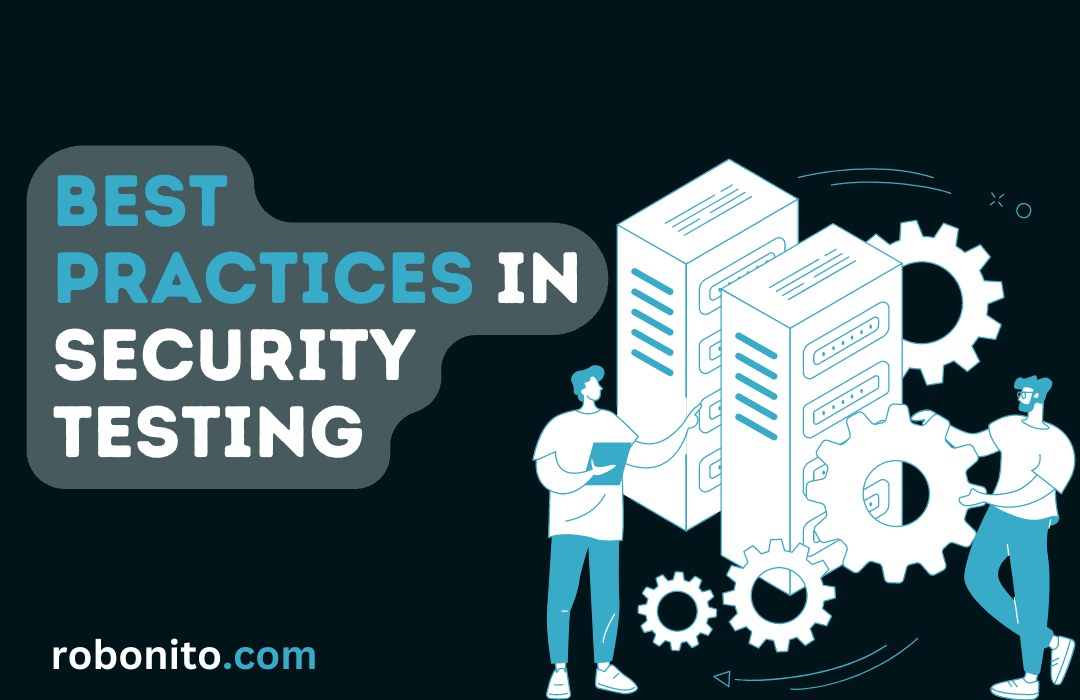This article will outline the key best practices in security testing for software development, covering various aspects and techniques to ensure the utmost security of software systems. In today's fast-paced digital landscape, software development is a crucial aspect of every industry. With the increasing reliance on technology, it is imperative to prioritize the security of software systems. However, the ever-evolving threat landscape poses significant challenges. That's why implementing best practices in security testing is essential to ensure robust protection against potential vulnerabilities and attacks.
Importance of Security Testing for Software Development

Security testing is not just an option; it's a necessity. The consequences of a security breach can be severe, ranging from financial losses to reputational damage. By conducting comprehensive security testing, software developers can identify and address vulnerabilities before they are exploited by malicious actors. This proactive approach enhances the overall security posture of software systems, safeguarding sensitive data and ensuring the trust of users and stakeholders.
Best Practices in Security Testing for Software Development

To maximize the effectiveness of security testing, Security Testing for Software should be integrated into every phase of the software development lifecycle. Starting from the requirements gathering phase to design, development, testing, and deployment, security considerations must be embedded at each step. This ensures that security is not an afterthought but a fundamental aspect of the development process. By addressing security early on, potential vulnerabilities can be mitigated before they become costly and time-consuming to fix.
Practice 1: Conducting Threat Modeling
Threat modeling is a proactive approach to identifying potential threats and vulnerabilities in software systems. It involves analyzing the system architecture, identifying potential entry points for attackers, and assessing the impact of potential attacks. By understanding the potential risks, developers can prioritize security efforts and allocate resources effectively.
Practice 2: Performing Code Review and Static Analysis
Code review and static analysis play a vital role in identifying security flaws in the software's source code. This process involves a careful examination of the codebase to identify coding errors, insecure coding practices, and potential vulnerabilities. Automated static analysis tools can assist in scanning the codebase for known security weaknesses, providing developers with actionable insights for remediation.
Practice 3: Implementing Dynamic Application Security Testing (DAST)
Dynamic Application Security Testing (DAST) involves analyzing the running application for potential vulnerabilities. By simulating real-world attacks, DAST tools can uncover security weaknesses that might not be apparent during static analysis. DAST helps developers understand how the application behaves under different conditions, enabling them to identify and address vulnerabilities related to input validation, authentication, and session management.
Practice 4: Employing Penetration Testing
Penetration testing, also known as ethical hacking, is an essential practice for assessing the security of software systems. It involves authorized individuals attempting to exploit vulnerabilities in a controlled environment. Penetration tests simulate real-world attacks, providing valuable insights into the effectiveness of security measures. By conducting regular penetration tests, developers can identify weaknesses and take proactive steps to fortify their software systems.
Practice 5: Conducting Security Testing for APIs
Application Programming Interfaces (APIs) serve as the backbone of modern software systems. However, they can also become entry points for attackers if not properly secured. Security testing for APIs involves assessing their authentication mechanisms, authorization processes, input validation, and output encoding. By thoroughly testing APIs, developers can ensure that they are not exposing sensitive data or providing unauthorized access to attackers.
Practice 6: Automating Security Testing
Automation is key to efficient and effective security testing. There are numerous security testing tools and frameworks available that can automate various aspects of the testing process. Automated security testing helps in identifying vulnerabilities, reducing human errors, and increasing the overall speed and accuracy of security assessments. By incorporating automation into the development workflow, developers can streamline security testing and enhance the resilience of their software systems.
Practice 7: Integrating Security Testing Tools
A wide range of security testing tools is available to aid developers in identifying vulnerabilities. These tools encompass different areas of security testing, such as code analysis, vulnerability scanning, and penetration testing. By integrating these tools into the development environment, developers can leverage their capabilities to identify and address security issues effectively.
Practice 8: Testing for Authentication and Authorization Vulnerabilities
Authentication and authorization vulnerabilities pose significant risks to software systems. Testing for these vulnerabilities involves verifying the strength of authentication mechanisms, ensuring the proper enforcement of access controls, and detecting any privilege escalation issues. By conducting thorough testing in these areas, developers can prevent unauthorized access and protect sensitive user data.
Practice 9: Ensuring Secure Data Storage and Transmission
Secure data storage and transmission are critical for protecting sensitive information. Encryption, secure protocols, and proper data sanitization techniques play a vital role in safeguarding data at rest and in transit. By ensuring the proper implementation of these security measures, developers can mitigate the risk of data breaches and unauthorized access.
Practice 10: Validating Input and Output Handling
Input and output handling vulnerabilities, such as injection attacks, are common avenues for attackers to exploit software systems. Proper input validation and output encoding are crucial to prevent such attacks. By thoroughly validating user input, developers can ensure that malicious data does not compromise the application's integrity. Additionally, output encoding techniques help prevent the execution of malicious scripts or code.
Practice 11: Performing Security Testing for Mobile Applications
Mobile applications have become ubiquitous, and their security is of paramount importance. Mobile app security testing involves assessing the application's code, data storage mechanisms, network communications, and user authentication methods. By testing mobile applications comprehensively, developers can identify vulnerabilities specific to the mobile environment and protect user data from unauthorized access.
Practice 12: Continuous Monitoring and Improvement
Security testing is not a one-time activity; it requires continuous monitoring and improvement. Threats and attack techniques evolve rapidly, and software systems must adapt to the changing landscape. By implementing continuous monitoring and regular security assessments, developers can detect new vulnerabilities and proactively address them. This iterative approach ensures that software systems remain secure even as new threats emerge.
Conclusion On Practices in Security Testing for Software Development
In today's digital world, security testing is indispensable for software development. By above discussed best Practices in Security Testing for Software Development process, developers can fortify their software systems against potential vulnerabilities and attacks. With proactive measures such as threat modeling, code review, dynamic testing, and penetration testing, developers can identify and address security weaknesses before they are exploited. Remember, security is a continuous effort, and staying vigilant is crucial to protect sensitive data and maintaining the trust of users and stakeholders.
Revolutionize your software testing with Robonito, the ultimate no-code RPA automation testing tool. Say goodbye to endless testing hours – Robonito slashes testing time by a staggering 98%! Ready to experience the future of software testing? BOOK A FREE DEMO NOW and transform your testing process today!
FAQs On Security Testing for Software Development
Why is security testing important in software development?
security Testing for Software Development is crucial to identify vulnerabilities, protect sensitive data, and prevent potential attacks. It ensures the reliability and integrity of the software, builds user trust, and mitigates financial and reputational risks.
How can security Testing for Software Development be integrated into the development lifecycle?
Integrate security Testing for Software Development at every stage of the development lifecycle: requirements gathering, design, development, testing, and deployment. Embedding security considerations early on saves time and resources by identifying and addressing risks proactively.
What role does penetration testing play in software security?
Penetration testing assesses system security by simulating real-world attacks. It helps identify vulnerabilities and allows developers to strengthen security measures in a timely manner.
How can secure data storage and transmission be ensured?
Ensure secure data storage and transmission by using encryption, secure protocols (like HTTPS), and proper data sanitization techniques to protect data at rest and in transit.
Why is continuous monitoring and improvement essential for security?
Continuous monitoring and improvement are necessary because the threat landscape constantly evolves. Regular monitoring detects emerging threats, while ongoing security assessments address vulnerabilities and adapt to changes, ensuring resilience against evolving risks.
